January 2017
January 22, 2017
Butterflies in my stomach
Ronald Taylor, a professor of pathology at the University of Southern California School of Medicine, was an early promoter of an insect-based diet. In the 1970s, he published two books on the topic: Butterflies in My Stomach: Insects in Human Nutrition (1975) and Entertaining With Insects, Or: The Original Guide to Insect Cookery (1976). Some of the recipes in the books included:- Boiled cod with snail sauce
- Wasp grubs fried in the comb
- Moths sauteed in butter
- Braised beef with caterpillars
- New carrots with wireworm sauce
- Gooseberry cream with sawflies
- Devilled chafer grubs
- Stag beetle larvae on toast
The full recipe for Peanut Butter Worm Cookies is below.



Posted By: Alex - Sun Jan 22, 2017 -
Comments (2)
Category: Food, Cookbooks, Insects and Spiders, 1970s
Mystery Illustration 37
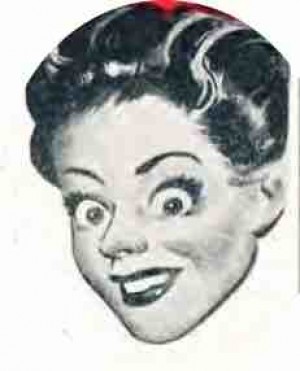
What horrors are causing the eyes of this Bride-of-Frankenstein lookalike to bug out?
Answer after the jump.
More in extended >>
Posted By: Paul - Sun Jan 22, 2017 -
Comments (4)
Category: Horror, Advertising, 1940s, Eyes and Vision, Face and Facial Expressions
January 21, 2017
Radium Cap
I'm guessing that if this actually worked to cure headaches it was because of the placebo effect. Although radium does, of course, produce heat, which might help a headache. But if there was enough radium in the cap to feel noticeably warm, it must have been incredibly dangerous.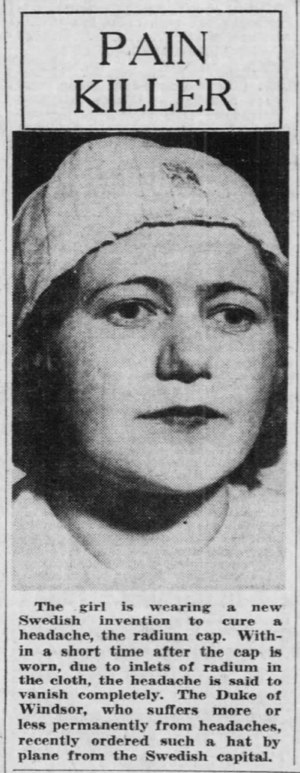
Pittsburgh Post-Gazette - June 11, 1937
Posted By: Alex - Sat Jan 21, 2017 -
Comments (21)
Category: Atomic Power and Other Nuclear Matters, Headgear, 1930s
St. Pancake Day
The Dutch cartoonist Jan Kruis, recently deceased, was responsible for proclaiming November 29th of every year to be the "Sint Pannekoek-feest," and getting the whole country to play along. The main tradition is to wear a pancake on your head.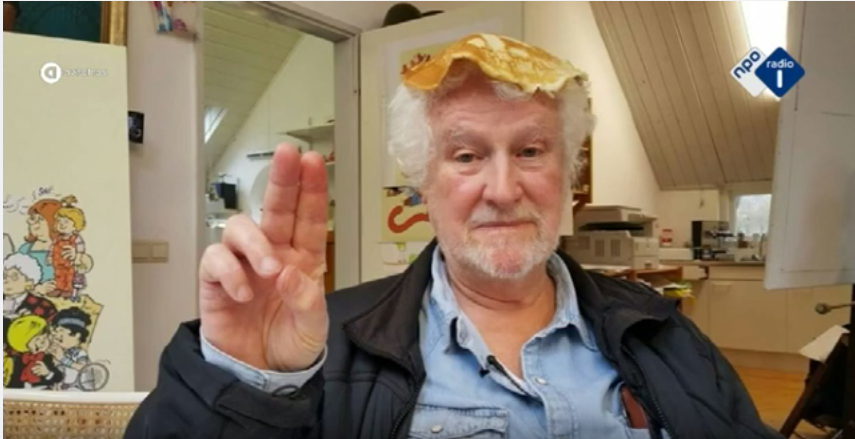
Posted By: Paul - Sat Jan 21, 2017 -
Comments (1)
Category:
January 20, 2017
When Billboards Become Visible
If you're in the billboard business you'd probably want to know exactly when a billboard becomes visible to drivers. So in 1953 research was conducted at the Iowa State College Experiment Station to get an answer to this question. The study involved having subjects watch miniature billboards slowly approach on a conveyor belt.Source: Duke University Libraries - Archives of the Outdoor Advertising Association of America.
The Duke University blog also notes that in 1958 "The OAAA commissioned Jack Prince, a professor of ophthalmology at Ohio State University, to study the visual dynamics of outdoor advertising, resulting in the first legibility studies of ad copy." I'm not sure how these two studies related to each other. They sound suspiciously similar. And the 1958 studies obviously weren't the first given that the pictures below show research labeled as happening in 1953.




Update: The researcher in the photos is probably Dr. A.R. Lauer of Iowa State's Department of Psychology, and he may have been studying the phenomenon of "Highway Hypnosis."
In the early 1950s there was increasing criticism of the proliferation of billboards along the side of roads. People complained that they were ugly and possibly distracted drivers. So the OAAA sponsored Dr. Lauer to research the safety benefits of billboards, and specifically whether billboards distracted drivers.
Lauer came up with the result that the billboards did distract drivers, but that this was a good thing because it saved them from Highway Hypnosis —entering a trance-like state as they stared at endless, monotonous roads.
The OAAA then took out ads in newspapers promoting Lauer's research and the safety benefits of billboards.

The Des Moines Register - Mar 23, 1958
Posted By: Alex - Fri Jan 20, 2017 -
Comments (9)
Category: Advertising, Experiments, 1950s, Billboards
Mount Mihara: Japan’s Suicide Volcano
If you really have to do yourself in, suicide by volcano sounds pretty dramatic and exciting.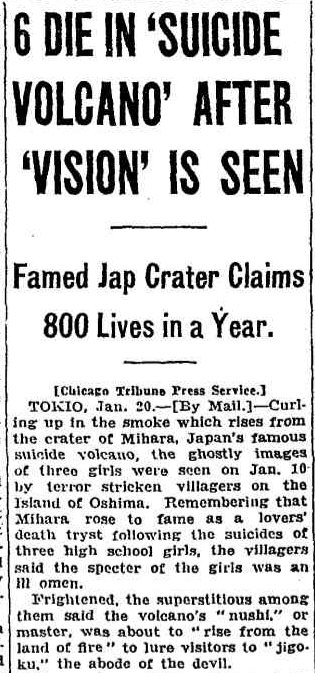
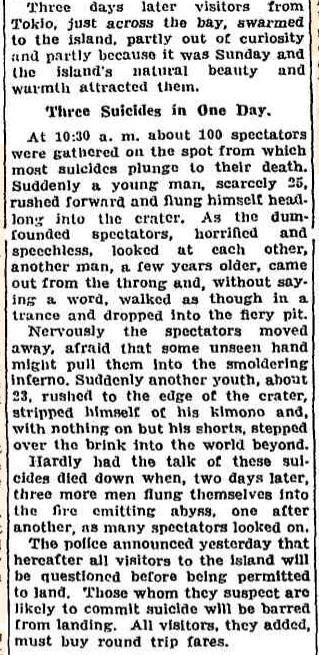
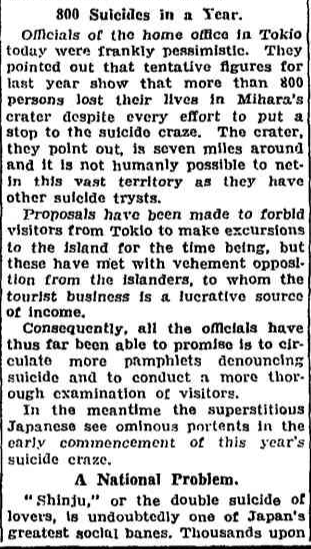
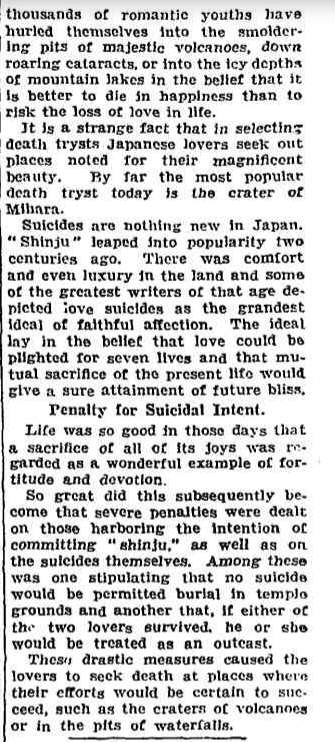
Original article here.
Wikipedia info here.
Posted By: Paul - Fri Jan 20, 2017 -
Comments (4)
Category: Death, Suicide, 1930s, Asia
January 19, 2017
Miniature Driving School
Back in the 1930s, if a Detroit judge suspected a driver was mentally unfit to be on the road, he might send the driver to see Dr. Lowell Selling, who would test the driver using a miniature street intersection to simulate various situations. However, I'm not sure what exactly this testing involved, beyond that vague description.I found a brief note about Dr. Selling in the Law Enforcement Executive Forum (2008, pdf, p.51):

St. Louis Post-Dispatch - Sep 13, 1936

Palladium-Item - Oct 21, 1936
Posted By: Alex - Thu Jan 19, 2017 -
Comments (2)
Category: Motor Vehicles, Psychology, 1930s
Devolution Through Beer
Posted By: Paul - Thu Jan 19, 2017 -
Comments (5)
Category: Body Modifications, History, Advertising, Anthropology, Dinosaurs and Other Antediluvian Creatures, Fish, Alcohol
January 18, 2017
Andor vs. And/Or
February 1953: The Georgia House of Representatives voted to make "andor" a legal word and directed that it should henceforth be used in place of the phrase "and/or." The House defined "andor" to mean, "either, or, both, and, and or or, and and or."However, the Georgia Senate voted against the bill.
More info: NY Times (Feb 21, 1953)

Minneapolis Star Tribune - Feb 28, 1953

The East Liverpool (Ohio) Evening Review - Feb 26, 1953
Posted By: Alex - Wed Jan 18, 2017 -
Comments (5)
Category: Languages, Law
Follies of the Madmen #301
The birth of the selfie generation.
Posted By: Paul - Wed Jan 18, 2017 -
Comments (6)
Category: Business, Advertising, Products, Family, Hobbies and DIY, Movies, 1950s
| Get WU Posts by Email | |
|---|---|

| Who We Are |
|---|
| Alex Boese Alex is the creator and curator of the Museum of Hoaxes. He's also the author of various weird, non-fiction books such as Elephants on Acid. Paul Di Filippo Paul has been paid to put weird ideas into fictional form for over thirty years, in his career as a noted science fiction writer. He has recently begun blogging on many curious topics with three fellow writers at The Inferior 4+1. Chuck Shepherd Chuck is the purveyor of News of the Weird, the syndicated column which for decades has set the gold-standard for reporting on oddities and the bizarre. Our banner was drawn by the legendary underground cartoonist Rick Altergott. Contact Us |

